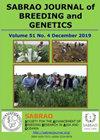ASSESSMENT OF BOTANICAL AND GENETIC COLLECTION OF SOYBEAN FOR MORPHOLOGICAL AND YIELD ATTRIBUTES AND THEIR IMPACT ON NODULE-ASSOCIATED BACTERIA AND SOIL FERTILITY
IF 1.7
Q3 PLANT SCIENCES
引用次数: 2
Abstract
Assessment of botanical and genetic collection of soybean cultivars transpired during 2021–2022, for morphological and yield-related traits and their impact on nodule bacteria and soil fertility, at the Dormon Scientific Experimental Station, Institute of Genetics, Academy of Sciences of the Republic of Uzbekistan, District Kibray, Tashkent region, Uzbekistan. The soybean cultivars, grown in a randomized complete block design, had a factorial arrangement with three replications. Results revealed that in the botanical collection, the highest seed yield per plant came from the soybean cultivar K-2600 (48.3 ± 1.30 g), 1000-grain weight from Bk-105 (215.9 ± 0.15 g), and the number of grains per plant from the genotype K-2600 (346.4 ± 6.48). Moreover, in the genetic collection, the high oil content resulted in the genotypes Gen-15 (20.11%), Gen-13 (19.46%), and Gen-11 (19.40%). The higher values of the total protein content emerged in the soybean cultivars, Ehtiyozh (34.09%) and Gen-9 (33.74%), Gen-19 (34.72%), and Gen-26 (33.08%). Among the two types of soybean collections studied, the most substantial number of root nodules appeared in the cultivar Sochilmas (96.65 ± 0.11) during the pod formation phase. The recorded highest amount of soil microelements, according to soil analysis, was at the sowing site of the soybean cultivar, Genetiс-1 and on average, the soil samples contained N-NO3 (28 mg/kg), mobile P2О (212.3 mg/kg), and volatile trace element K2О5 (36 mg/kg), found to remain in the soil after crop harvesting. The conclusion based on the results indicates that the local soybean cultivar Genetik-1 has a more positive effect on improving soil fertility versus the other genotypes in both collections.大豆植物和遗传资源的形态和产量属性评估及其对结瘤菌和土壤肥力的影响
2021年至2022年期间,在乌兹别克斯坦共和国科学院遗传学研究所多蒙科学实验站,乌兹别克斯坦塔什干地区基布雷区,对大豆品种的植物学和遗传学收集进行了评估,以了解形态和产量相关性状及其对根瘤菌和土壤肥力的影响。在随机完全区组设计中生长的大豆品种具有三次重复的因子安排。结果表明,在植物群中,大豆品种K-2600的单株种子产量最高(48.3±1.30 g),Bk-105的1000粒重最高(215.9±0.15 g),单株粒数最高(346.4±6.48),大豆品种Ehtiyozh(34.09%)和Gen-9(33.74%)、Gen-19(34.72%)和Gen-26(33.08%)的总蛋白质含量较高。根据土壤分析,记录在案的土壤微量元素含量最高的是大豆品种Genetiс-1的播种点,平均而言,土壤样品含有N-NO3(28 mg/kg)、流动性P2О(212.3 mg/kg)和挥发性微量元素K2О5(36 mg/kg),这些元素在作物收割后残留在土壤中。结果表明,与两个品种相比,本地大豆品种Genetik-1在提高土壤肥力方面具有更积极的作用。
本文章由计算机程序翻译,如有差异,请以英文原文为准。
求助全文
约1分钟内获得全文
求助全文
来源期刊

Sabrao Journal of Breeding and Genetics
农林科学-奶制品与动物科学
CiteScore
1.90
自引率
50.00%
发文量
63
期刊介绍:
The SABRAO Journal of Breeding and Genetics is an international journal of plant breeding and genetics research and was first published in 1969. It is the official publication of the Society for the Advancement of Breeding Research in Asia and Oceania (SABRAO).
Its objectives are to: promote the international exchange of research information on plant breeding and genetics, by describing new research findings, or ideas of a basic or practical nature; and be a medium for the exchange of ideas and news regarding members of the Society.
The Journal gives priority to articles that are of direct relevance to plant breeders and with emphasis on the Asian region. Invited for publication are research articles, short communications, methods, reviews, commentaries, and opinion articles. Scientific contributions are refereed and edited to international standards.
The journal publishes articles for SABRAO members mainly. The Journal preferred strongly that at least one author should be a current member of the Society. Non-members may also publish in the journal.
 求助内容:
求助内容: 应助结果提醒方式:
应助结果提醒方式:


